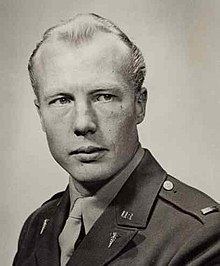Name Christian Lambertsen | ||
 | ||
Born May 15, 1917Westfield, New Jersey ( 1917-05-15 ) Nationality United States of America Institutions Institute for Environmental Medicine, University of Pennsylvania Medical Center, Philadelphia, Pennsylvania...(more)... Alma mater - Rutgers University, New Brunswick, New Jersey – B.S. (1939)- University of Pennsylvania, Philadelphia, Pennsylvania – M.D. (1943) Doctoral students J.M. Clark, J.N. Feld, R.E. Peterson, J.M. Collins, S. Kronheim, M.L Gernhardt, L.H. Fenton Known for Research in tolerance and toxicity of respiratory gasses and development of diving procedures and equipment. Died February 11, 2011, Newtown Square, Pennsylvania, United States Residence Newtown Square, Pennsylvania, United States Awards John Scott Legacy Medal and Premium Fields | ||
Christian James Lambertsen (May 15, 1917 – February 11, 2011) was an American environmental medicine and diving medicine specialist who was principally responsible for developing the United States Navy frogmen's rebreathers in the early 1940s for underwater warfare. Lambertsen designed a series of rebreathers in 1940 (patent filing date: 16 Dec 1940) and in 1944 (patent issue date: 2 May 1944) and first called his invention breathing apparatus. Later, after the war, he called it Laru (portmanteau for Lambertsen Amphibious Respiratory Unit) and finally, in 1952, he changed his invention's name again to SCUBA (Self Contained Underwater Breathing Apparatus). Although diving regulator technology was invented by Émile Gagnan and Jacques-Yves Cousteau in 1943 and wasn't originally related to rebreathers, the current use of the word SCUBA is largely attributed to Gagnan's and Cousteau's invention. The US Navy considers Lambertsen to be "the father of the Frogmen".
Contents

Education
Lambertsen was born in Westfield, New Jersey and attended Rutgers University in New Brunswick, New Jersey, graduating in 1939 with a bachelor of science degree. He graduated from medical school at University of Pennsylvania, Philadelphia, Pennsylvania in 1943.
Lambertsen was awarded Honorary Doctor of Science Degree from Northwestern University in 1977.
Army career
Major Lambertsen served in the U.S. Army Medical Corps from 1944 to 1946. He invented the first Self-contained Underwater Breathing Apparatus (SCUBA) and demonstrated it to the Office of Strategic Services (OSS) (after already being rejected by the U.S. Navy) in a pool at a hotel in Washington D.C. OSS not only bought into the concept, they hired Major Labertsen to lead the program and build-up the dive element of their maritime unit. He was vital in establishing the first cadres of U.S. military operational combat swimmers during late World War II. The OSS was also the predecessor of the Central Intelligence Agency (CIA) and the maritime element still exists inside their Special Activities Division.
His responsibilities included training and developing methods of combining self-contained diving and swimmer delivery including the Lambertsen Amphibious Respiratory Unit for the OSS "Operational Swimmer Group". Following World War II, he trained U.S. forces in methods for submerged operations, including composite fleet submarine / operational swimmers activity.
Civilian career
From 1946 to 1953 Lambertsen served as an instructor to Professor of Pharmacology with the Department of Pharmacology at the University of Pennsylvania School of Medicine though he did spend a year as a Visiting Research Associate Professor from 1951 to 1952 for the Department of Physiology at University College London, England. Lambertsen spent the 1950s concentrating on national research needs in undersea medicine (see National Service Activities below). He again took an appointment as Professor of Pharmacology and Experimental Therapeutics at the University of Pennsylvania School of Medicine in 1962. He was also named Professor of Medicine in 1972 and Professor at the University of Pennsylvania School of Veterinary Medicine in 1976. Each of these appointments were held until 1987. In 1985, he became Emeritus Distinguished Professor of Environmental Medicine at the University of Pennsylvania.
Lambertsen was the founder and director of The Environmental Biomedical Stress Data Center at the University of Pennsylvania in Philadelphia, Pennsylvania.
The University of Pennsylvania's annual Christian J. Lambertsen Honorary Lecture is named for him. On May 31, 2007 the guest speaker was Professor Marc Feldmann, head of Imperial College's Kennedy Institute of Rheumatology who is recognised for his discovery of anti-TNF treatment for rheumatoid arthritis, which has led to a new therapy used by more than a million patients. Dr. Lambertsen was in attendance.
Predictive Studies Series
Dr. Lambertsen's "Predictive Studies Series", spanning from 1969 with TEKTITE I to 1997, researched many aspects of humans in extreme environments.
